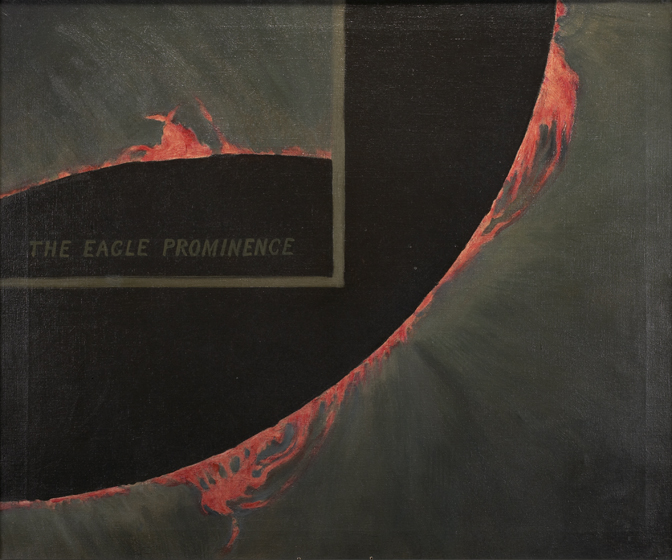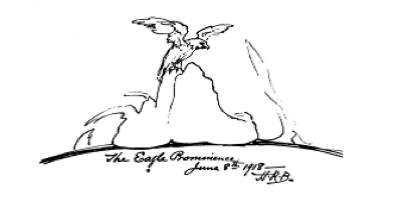Howard Russell Butler’s Prominences
By the mid-nineteenth century, astronomers came to realize that eclipses provided a unique way to study the nature of the sun. One surprising observation —made separately by Richard C. Carrington and R. Hodgson—was the visibility during a solar eclipse of large-scale jets of glowing red hydrogen gas shooting out from the (eclipsed) disk of the sun and large enough to show beyond the disk of the obscuring moon. It was quickly shown that these jets actually came from the sun (not the moon) and were normally invisible in the general glare from the sun. For some decades they could be seen and studied only during total eclipses.
Butler was prepared to capture the image of prominences at the 1918 eclipse and had binoculars at hand to study them once the eclipse was underway. The prominences were particularly visible, and Butler was able to include them in his painting. He then made another painting of the details of the prominences, using black-and-white photographs taken of the eclipse and his notes of their color.

Image#b1000010_2 © American Museum of Natural History Library

Image#b1000010_4 © American Museum of Natural History Library
Image#b1000010_3 © American Museum of Natural History Library
New types of astronomical equipment were developed at the end of the nineteenth century that made it possible to observe solar prominences—which normally could not be seen due to the much stronger light of the disk of the sun—without having to wait for an eclipse. During an eclipse, the main light from the sun was hidden by the moon’s disk, and the prominences, which stuck out from the sun, could be seen. In 1893 a device called a “spectroheliograph” was invented, which let the light from the prominences be photographed by reducing the glare from the disk of the sun. The prominences thus could be studied without waiting for an eclipse to make them visible.
By 1920 there were a large number of these photographs of prominences, taken at a number of observatories. Howard Russell Butler obtained and studied these photographs and made five large-scale paintings of them, using the colors he had observed at the 1918 eclipse. His use of color and expressive brushstrokes convey the dynamics, power, and scale of a solar flare.

“All solar prominences are large. This one was especially large, and Howard Russell Butler made sure you knew it by discreetly painting a tiny disc at the top to represent the relative size of Earth. Without the benefit of research conducted later on the properties of the sun’s surface, and without time-lapsed photography, Butler did not know that these ejected plumes of plasma actually follow the smoothly curved loops of magnetic fields that punch through the sun’s surface. The jagged edges of the prominence are not so much what Butler saw but what he perceived.”
Neil deGrasse Tyson, astrophysicist and Director, Hayden Planetarium
Howard Russell Butler, American, 1856–1934
The Eagle Prominence, 1918
Oil on canvas
Princeton University, gift of H. Russell Butler Jr.
PP358
There was a particularly notable solar prominence at the 1918 eclipse that Butler dubbed “The Eagle” because of its shape, which he detailed in this painting.
“Many arches were found springing over the prominences, and a few rifts or dark channels radiating from the limb but never coming very close to it. The negatives showed very clearly the hairy polar rays, not always radial in direction, and the beginning of a wing springing from the upper right-hand limb of the sun.”
American Museum of Natural History. (1919). Natural History. New York, N.Y.: American Museum of Natural History, p. 271.

